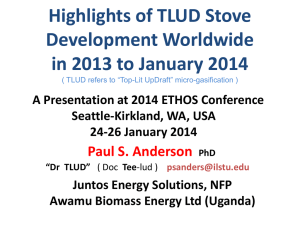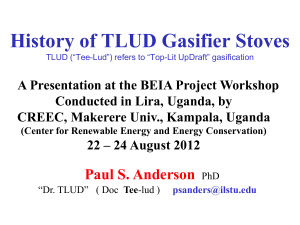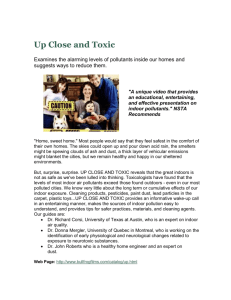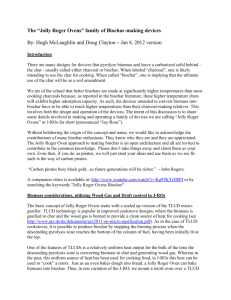IAP Presentation
advertisement
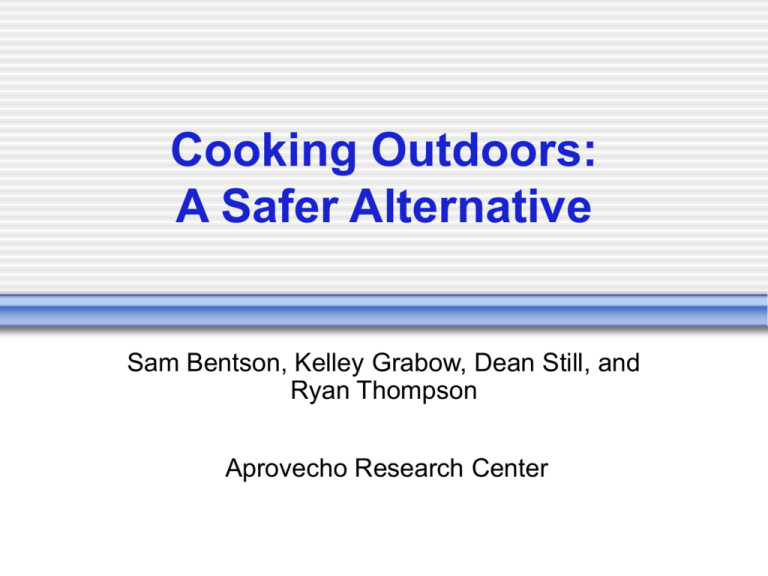
Cooking Outdoors: A Safer Alternative Sam Bentson, Kelley Grabow, Dean Still, and Ryan Thompson Aprovecho Research Center Introduction • What is indoor air pollution (IAP)? • How do stoves affect IAP? •Why is indoor cooking a problem? •1,500,000 deaths per year1 1. http://www.who.int/indoorair/publications/nationalburden/en/index.html Background • • • • WHO standards updated in 2010 Johnson, Monte Carlo box model Smith, RESPIRE study Seen in literature: “[IAQ] ranks second only to poor water/sanitation/hygiene among environmental health risk factors.”1 “Improved ventilation of the cooking and living area can contribute significantly to reducing exposure to smoke.”2 But also: “The largest reductions in indoor air pollution can be achieved by switching from solid fuels (biomass, coal) to cleaner and more efficient fuels…”2 1. Naeher, L. P., Smith, K. R., et al., Critical Review of the Health Effects of Woodsmoke, 2005. 2. http://www.who.int/indoorair/interventions/en/, accessed 25 January, 2011. Project Objectives • Goal: Compare emissions of traditional & improved biomass stoves, both inside & outside Show basic methods of reducing emissions exposure Project Objectives • Why? • Get solid scientific support Cooking location recommendations Funding projects • Demonstrate use of IAP in field Methodology • IAP meter • Technical specifications CO detector PM detector Methodology • Written protocol Based on typical cooking task Collect data for 60 minutes • Experimental setup Test kitchen volume ~10 m3 IAP monitor ~1 m horizontally and ~1 m vertically from stove center Open fire TLUD Experimental Results Test Kitchen Ventilation Rates 12.0 11.0 Air Changes per Hour (h-1) 9.9±1.1 10.0 9.0 8.5±2.5 8.0 7.0 6.0 5.0 4.0 3.0±0.4 3.7±0.1 Closed Kitchen Hole in Roof Open 3.0 2.0 Door Open Door & Window Open Findings • Indoor performance Open fire TLUD Stove Measurement 3 Stone Fire Inside Average PM concentration TLUD Inside Average PM concentration 3 Stone Fire Inside Average CO concentration TLUD Inside Average CO concentration Units Estimated meant value * estimated standard deviation of the mean ug/m3 11664.7 5760.4 ug/m3 1848.6 643.4 ppm 85.9 36.9 ppm 17.6 13.6 Findings • Outdoor performance Open fire TLUD Measurement Average PM concentration Average PM concentration Average CO concentration Average CO concentration Units Estimated mean t value * estimated standard deviation of the mean ug/m3 261.9 6.80E-08 ug/m3 170.5 267.1 ppm 2.6 4.30E-10 ppm 1.5 2.8 More detailed information about how data were processed may be seen on the penultimate slide “Data Processing”. Estimated Mean Particulate Matter Concentration 18000 16000 14000 10000 3 g/m 12000 8000 6000 4000 2000 0 3 Stone Fire Inside 3 Stone Fire Outside TLUD Inside TLUD Outside Estimated Mean Carbon Monoxide Concentration 140 120 100 ppm 80 60 40 20 0 3 Stone Fire Inside 3 Stone Fire Outside TLUD Inside TLUD Outside Emissions Exposure as Measured by IAP Meter Backpack Outdoors and Indoors for Three-Stone Fire and TLUD 14,000 100 PM CO 12,000 90 80 70 Three-Stone: 97% Reduction from Indoor to Out 8,000 60 50 6,000 TLUD: 92% Reduction from Indoor to Out 4,000 40 30 20 2,000 10 0 0 Three-Stone Indoor Three-Stone Outdoor TLUD Indoor TLUD Outdoor CO (ppm) PM (ug/m3) 10,000 Results 24-Hour Mean PM Concentrations in Test Kitchen (Extrapolated From 1-Hour Concentrations) 250 Door Open Door & Window Open WHO PM2.5 24-hour Standard 200 143.2 µg/m3 150 121.6 100 78.9 43.6 50 6.7 0 TSF Rocket Stove TLUD 5.7 25 µg/m3 Results 1-Hour Mean CO Concentrations in Test Kitchen 60 Door Open Door & Window Open 50 WHO 1-hour CO Standard 43.0 ppm 40 27.5 30.8 30 ~31 ppm (35 µg/m3) 20 8.3 10 3.6 0 TSF Rocket Stove TLUD 2.9 Conclusions and Discussion • • • • Improvement of TLUD over open fire What was statistically significant? What was not statistically significant? Why is that important? Recommendations • Is it better to cook outdoors on a traditional fire, or to cook on a TLUD, in terms of: Health? Deforestation? Climate change? Issues yet to be addressed • Will more stoves be tested? • What if a cook cannot cook outside? • What about outdoor air pollution? Looking forward • Continue testing • Key points to remember for future Emissions Ventilation Location Stove End user Sources Referenced and Cited • • • • • • Aprovecho Research Center, Shell Foundation, et al. Comparing Cook Stoves. Dasgupta, S., Huq, M., et al. Indoor Air Quality for Poor Families: New Evidence from Bangladesh. Development Research Group, World Bank Policy Research Working Paper 3393, 2004. Desai, M. A., Mehta, S., & Smith, K. R. Indoor smoke from solid fuels: assessing the environmental burden of disease at national and local levels. Geneva, WHO, 2004. Figliola, R. S., et al. Theory and Design for Mechanical Measurement, Wiley, 2006. Naeher, L. P., Smith, K. R., et al. Critical Review of the Health Effects of Woodsmoke, 2005. Rubinson, K. A., & Rubinson, J. F. Contemporary Instrumental Analysis, Prentice Hall, 2000. Data Processing • Error Analysis Standard format True mean () Estimated mean (m) Estimated standard deviation of mean (sm) Student’s t at 95% (t(N-1,95)) Reporting and display = m ± t(N-1,95)•sm Bar graphs display m Error bars display ± t(N-1,95)•sm Acknowledgements Thanks to: Dean Still, Sam Bentson,Ryan Thompson, Karl Walters, Nordica Hutchinson, and all Aprovecho staff and volunteers
